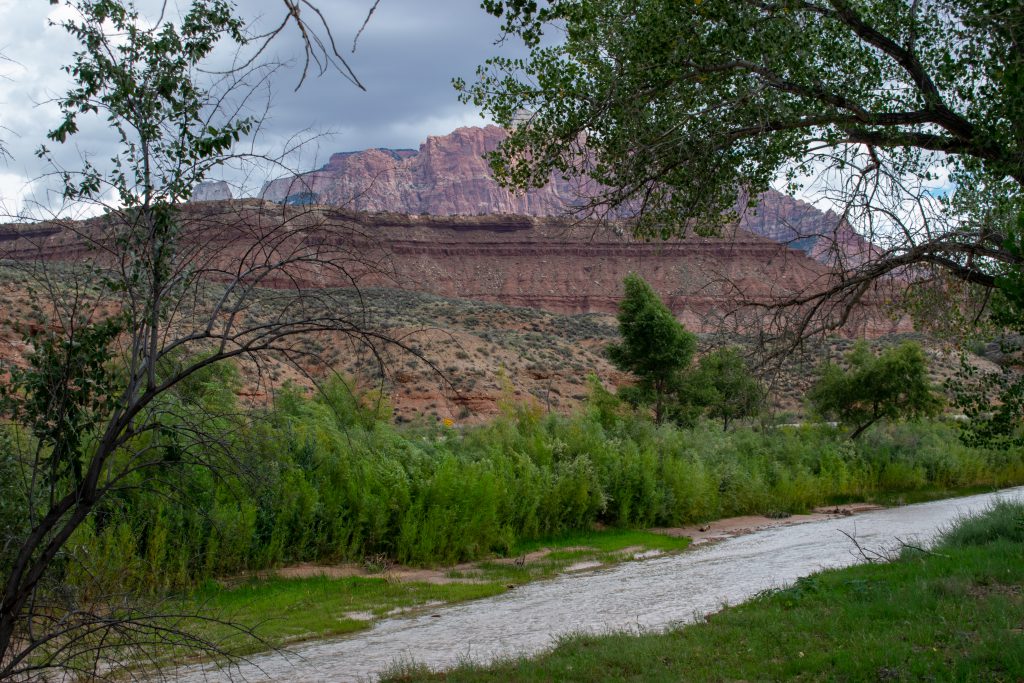
WASHINGTON COUNTY, Utah – Driving down SR-9 in Washington County, travelers are often overcome by the grandeur of the scenery that dots the landscape. Unknown to visitors traveling this route is a multi-year project that has been taking place along the Virgin River.
For the past three years, Southwest Area Forester Carrie Howard has been working with private land owners, the Bureau of Land Management and The Nature Conservancy to remove invasive tree species on 250 acres of land along the river to improve water flow, especially during times of high water, and enhance the watershed.
“Removal of invasive species along the Virgin River has been an ongoing battle for multiple years, with high involvement from Zion National Park and the Town of Springdale,” said Howard. “Within the last three years, this project has focused on moving downriver to expand the treatment into Rockville, Grafton, and Virgin. It will require multiple phases of treatment to remove Russian olive and tamarisk from this watershed. Continued landowner involvement in monitoring and removing any resprouts has significantly contributed to this project’s success.
Tamarisk and Russian olive are two trees that are considered invasive species in the area. Both trees grow near water sources and were initially introduced to control erosion. The unintended consequence of introducing these trees into the ecosystem was the change they would have on the river bank and the wildlife habitat.
Over decades, tamarisk and Russian olive have hindered the river from following its natural course and created a single channel. They have inhibited the natural flow during high water periods leading to undesired floodplains. The water that flows through this watershed is upstream from the Quail Creek Diversion Dam, which captures water for the Hurricane Hydropower Plant and is then stored as a municipal water source at Sand Hollow Reservoir.
By removing invasive plants, Howard hopes the river will return to its historic floodplain and restore native vegetation, providing needed habitat for fish and birds while also increasing water quality and quantity in the watershed.
“Native vegetation is adapted to flooding. Cottonwood and willow seeds are only viable for several weeks after seed dispersal and require moist soils to germinate. This area of the Virgin River is unique, as it still allows for natural flooding. Removal of non-native species in this area will help restore historic floodplains and increase cottonwood and willow regeneration,” says Howard.
As Utah continues to experience drought conditions, it is crucial to rid the landscape of invasive species and allow native trees to grow and flourish. With limited annual rainfall, the vegetation of these ecosystems is dependent on groundwater. Long taproot trees like Tamarisk and Russian Olive can access the water table and deplete it during low water years, causing the more native shallow taproot species, such as cottonwood, to die from a lack of water.
Treatments have been done using crews to remove the invasive species by hand and then follow up with herbicide using a cut-stump method. Cut-stump is where herbicide is applied to a freshly cut stump, allowing the tree to absorb the chemicals and effectively killing the tree’s root system. Cut materials are then placed in slash piles to either be chipped or burned depending on the location, access, and time of year.
As this project funding is in its final stages, Howard and the other land managers involved in the project will continue to monitor the area and evaluate the effectiveness of the project.
Due to this multi-agency work, visitors and residents will continue to experience the beauty the area provides and reap the continued benefits.
